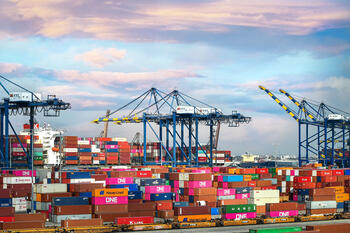
For a generation, the Long Beach and Los Angeles harbors in California handled more than 40 percent of all container cargo headed into the US and epitomized the power of a globalizing economy. Today, the ships—mostly from Asia—still dock, but they must wait in a seemingly endless conga line of as many as 60 vessels, sometimes for as long as three weeks. These are the worst delays in modern history, and the price per container has risen to as much as 10 times its cost before the pandemic. The shipping crisis is now projected to last through 2023.
A pandemic-driven shortage of parts and labor has combined with a congested transport system to create an inflationary spike, with shipping rates doubling on some routes. Prices for everything from soybeans to natural gas have soared as supplies take longer to produce and arrive, and this high inflation is wiping out wage gains in the US, the UK, and Germany. The chaos on the ground may not disturb the lifestyles of the tech and financial elites, but it is hurting the middle and working classes, the groups most threatened by surging inflation.
The supply chain disaster has also revealed the existence of crippling economic dependence, particularly on China, in high-income countries. Today, whole industries in the West—from medical equipment to chip and car makers to food—rely on China for finished products and key components. When China cannot (or decides not to) supply these parts, whole industries suffer debilitating supply chain shortages. The notion of a rational, self-regulating market system is unraveling and may yet presage the demise of the prevailing neoliberal era.
Walking away from production
For generations, business consultants have persuaded businesses large and small to move their production to China in search of cheaper costs. This has had a devastating effect, particularly in the United States, where between 2004 and 2017, the share of world manufacturing shrank from 15 to 10 percent while reliance on Chinese inputs doubled. The trade deficit with China, according to the Economic Policy Institute, has cost as many as 3.7 million jobs since 2000. The consequences have also been severe in the UK, which suffered 1.5 million job losses in manufacturing between 1997 and 2009, in part due to climate policies that threaten the last vestiges of heavy industry in the country that invented it.
In the face of these trends, the general response of the Western elites has been “Why worry?” Reflecting the ideological leanings of the American establishment, Christina D. Romer, the former head of the Council of Economic Advisers in the Obama administration, dismissed concerns about manufacturing policy as nostalgic “sentiment,” declaring, “American consumers value health care and haircuts as much as washing machines and hair dryers.”
But unlike the local hair salon, the market for washing machines is national and global and these goods have to be transported, often over great distances. A factory that makes parts for washing machines in a city, state, or region draws money to the local community. Moreover, manufacturing has one of the highest multiplier effects of any sector—one manufacturing job in a community is likely to generate numerous other direct, indirect, and induced jobs, both locally and elsewhere.
Pandemic lessons
In the midst of the pandemic, even the world’s richest regions—the European Union, the United Kingdom, North America—found themselves without basic medical equipment like masks, and even the compounds needed to make critical chemical treatments. In the early critical months, “China's decision to block exports of these goods led to widespread shortages,” observes Richard Haass, President of the Council on Foreign Relations. “There is also the concern that an increasingly assertive China might seek to exploit the world's dependence on it for political purposes.”
This disaster, now playing out across the industrial landscape, reflects the fracturing of supply chains over several decades. A generation of politicians, economists, and pundits, particularly in Anglo-Saxon countries like Australia, have paid little attention to nurturing the “industrial commons,” which encompass production, research and development, supply chains, embedded process development, and engineering capacity.
This pattern affects industries besides medical equipment. This year, auto production was curtailed due to a worldwide shortage of semiconductors tied to a recent drought in Taiwan. America’s push into renewables threatens to further bolster China’s dominance of the solar panel industry and production of the essential metals needed to produce “clean” energy and electric cars. The West’s trade deficit now extends even to high-tech products. When companies move production abroad, they often shift research and development as well. Remarkably, this has also included sources of critical components for military goods, many of which are now produced in China.
Reshoring: A possible answer
Camille Farhat—a former top executive at General Electric, Baxter, and Medtronic, and now CEO of Michigan-based manufacturer RTI Surgical—told me that many products, including medical supplies, can be produced domestically. Farhat hopes the pandemic will convince other business leaders to stop “destroying the supply ecosystem” that makes production possible. “To stay safe, you have to do contingency planning—you have to restore the network and maintain surplus production capacity. Hopefully, we are learning that lesson.” There are signs that some are heeding Farhat’s advice. Japan, France, the UK, and the European Union all recognize that dependence on China carries enormous political and economic risks. Japan is even offering loans to lure companies back home from China.
Read the rest of this piece at Quillette.
Joel Kotkin is the author of The Coming of Neo-Feudalism: A Warning to the Global Middle Class. He is the Roger Hobbs Presidential Fellow in Urban Futures at Chapman University and Executive Director for Urban Reform Institute. Learn more at joelkotkin.com and follow him on Twitter @joelkotkin.
Photo: Barrett Ward via Unsplash under Public Domain.













Longshore
Before reorienting the whole economy to an onshore production model, could we try dealing with the docks problem? Is this an outgrowth of the ILWU's cartel, in part? Skilled or less-skilled positions? Could the military be brought in to fill?